I can do this on my Lee Classic Cast single stage, but not on any of my progressives. For the progressives, I loosen the lock-ring and adjust the bodyI can tell by the feel of the handle when the case mouth hits the bell. I stop there and lower the ram. It works for me. I don’t think it’s going to work for @CQB45ACP or anyone else.
You are using an out of date browser. It may not display this or other websites correctly.
You should upgrade or use an alternative browser.
You should upgrade or use an alternative browser.
Why No Micrometer Adjusting Expanders?
- Thread starter CQB45ACP
- Start date
GeoDudeFlorida
Member
- Joined
- Dec 1, 2020
- Messages
- 11,086
I’ve never used a progressive but I have read a lot about the negative effects of “short-stroking” so I’m going to guess that it’s not a good idea. Should be fine for a turret press, though.I can do this on my Lee Classic Cast single stage, but not on any of my progressives. For the progressives, I loosen the lock-ring and adjust the body
The Lee hand press is a sweetheart for expanding rifle brass. I can feel the bumps where the expander hits the case mouth, where the M flair hits and where the expander bottoms out. I use the NOE expander’s in the Lee Universal case expander body with a spacer made of Delrin.
OH, OK....These would work if I was looking to move the die but as it is right now, I only have to move the stem and I’m after a better way to do the latter.
View attachment 1171451
There's a depth gauge on the back of all calipers dial or digital, use it like this:
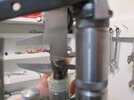
I take the nut off and tape over the expander after adjusting it, so I know it has not moved/turned.
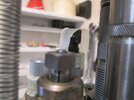
If you know the pitch of the thread dividing 1 by the pitch will get you the amount the screw advances per revolution.
As an example: a 1/4x20 thread would be 1 divided by 20 (the pitch) equals 0.050" per revolution.
Stay with me here...
So, 1/2 turn would equal 0.025", 1/4 quarter turn equals 0.0125", 1/8 turn equals 0.0065"
If you scratch a radial line on the expander, it's easy to eyeball a 1/2, 1/4, 1/8 turn and the equivalent advancement of the screw.
This works for seaters too.
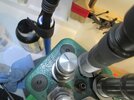
So, there you have it, a rough adjustment with a line, and a fine adjustment with a Caliper.
Once you hit the sweet spot measure the screw position with your caliper and record it in your load data for reference.
Additional equipment/cost, none/none.
jmo,
.
Last edited:
CQB45ACP
Member
Hey I appreciate the step by stepOH, OK....
There's a depth gauge on the back of all calipers dial or digital, use it like this:
View attachment 1171638
I take the nut off and tape over the expander after adjusting it, so I know it has not moved/turned.
View attachment 1171639
If you know the pitch of the thread dividing 1 by the pitch will get you the amount the screw advances per revolution.
As an example: a 1/4x20 thread would be 1 divided by 20 (the pitch) equals 0.050" per revolution.
Stay with me here...
So, 1/2 turn would equal 0.025", 1/4 quarter turn equals 0.0125", 1/8 turn equals 0.0065"
If you scratch a radial line on the expander, it's easy to eyeball a 1/2, 1/4, 1/8 turn and the equivalent advancement of the screw.
This works for seaters too.
View attachment 1171640
So, there you have it, a rough adjustment with a line, and a fine adjustment with a Caliper.
Once you hit the sweet spot measure the screw position with your caliper and record it in your load data for reference.
Additional equipment/cost, none/none.
jmo,
.
I’ll fine tune my paint marks as a test.
NMexJim
Member
You mentioned that you have Redding dies. Why not give them a call and see if they might want to work with you? One never knows. That might be an interesting conversation.
CQB45ACP
Member
Nothing to loseYou mentioned that you have Redding dies. Why not give them a call and see if they might want to work with you? One never knows. That might be an interesting conversation.
I’ll give it a try
I guess if micrometer adjusters for the flare/expanding die were available, I’d probably invest. I’m a tool junkie
But in reliably, once I get an expander die set, rarely make changes to the setting.
For handgun cases that get a roll crimp, I trim the cases so I get a uniform crimp. So, when expanding, with trimmed cases, the case expanding is about the same case to case.
With rounds that I taper crimp, the allowable variance is greater, both with expanding the case mouth and with taper crimping. The taper crimp primarily removes the flare.
Of course, nothing replaces the need for adequate neck tension.
But in reliably, once I get an expander die set, rarely make changes to the setting.
For handgun cases that get a roll crimp, I trim the cases so I get a uniform crimp. So, when expanding, with trimmed cases, the case expanding is about the same case to case.
With rounds that I taper crimp, the allowable variance is greater, both with expanding the case mouth and with taper crimping. The taper crimp primarily removes the flare.
Of course, nothing replaces the need for adequate neck tension.
jmorris
Member
- Joined
- Sep 30, 2005
- Messages
- 24,211
BUT I want a micrometer. And know how it could be made rather simply albeit rather expensively as a one off.
Im thinking I can buy several expander dies and several micrometers give them to a skilled machinist and end up with what I want. $1000 should do it.
It would have to be engineered by someone that didn’t have complete understanding of various methods of manufacturing to get to a price that high, just to have the ability to adjust something to the thousandth or better.
Obtain a thimble from a micrometer.
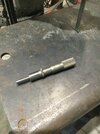
And get a split set collar that will hold it and weld that to what you want to be able to adjust, just like any other knob. That’s what I did on this barrel test fixture.
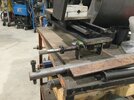
This would be less expensive than that Starrett.
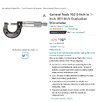
Jim Watson
Member
I can tell by the feel of the handle when the case mouth hits the bell. I stop there and lower the ram.
A friend used a variant of that for flaring and crimping.
He did not set the lock ring but held the loose die in his off hand and rocked it through enough of a turn to feel the die engage.
CQB45ACP
Member
Okay, step one complete.It would have to be engineered by someone that didn’t have complete understanding of various methods of manufacturing to get to a price that high, just to have the ability to adjust something to the thousandth or better.
Obtain a thimble from a micrometer.
View attachment 1171682
And get a split set collar that will hold it and weld that to what you want to be able to adjust, just like any other knob. That’s what I did on this barrel test fixture.
View attachment 1171683
This would be less expensive than that Starrett.
View attachment 1171686
But would my grandfather be okay with me canabalizing his stuff?
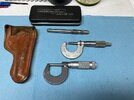
CQB45ACP
Member
I haven’t tried that one yet.A friend used a variant of that for flaring and crimping.
He did not set the lock ring but held the loose die in his off hand and rocked it through enough of a turn to feel the die engage.
jmorris
Member
- Joined
- Sep 30, 2005
- Messages
- 24,211
Okay, step one complete.
But would my grandfather be okay with me canabalizing his stuff?
No, especially for this.
My mind is weird, it works on stuff as I sleep. I woke up this morning in metric. A circle with a circumference of 71.4 mm (number of thousandths vertical in a turn of a 14 TPI thread) has a diameter of 22.7mm.
22.7mm happens to be .8767 inches.
7/8 of an inch diameter, like our dies, in decimal form is .875 inches.
All you really need is an adhesive metric ruler, cut off at 71mm and wrapped around the threads of the die, each graduation ~.001.
Should save you about $990 from your previous estimate.
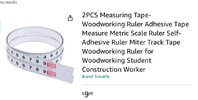
GeoDudeFlorida
Member
- Joined
- Dec 1, 2020
- Messages
- 11,086
Just use the one I already posted.Okay, step one complete.
But would my grandfather be okay with me canabalizing his stuff?
View attachment 1171703
CQB45ACP
Member
Actually THIS WILL scratch the itch for a while.No, especially for this.
My mind is weird, it works on stuff as I sleep. I woke up this morning in metric. A circle with a circumference of 71.4 mm (number of thousandths vertical in a turn of a 14 TPI thread) has a diameter of 22.7mm.
22.7mm happens to be .8767 inches.
7/8 of an inch diameter, like our dies, in decimal form is .875 inches.
All you really need is an adhesive metric ruler, cut off at 71mm and wrapped around the threads of the die, each graduation ~.001.
Should save you about $990 from your previous estimate.
View attachment 1171705
Now go back to dreamland
CQB45ACP
Member
Yeah but it didn’t make for an instant clever responseJust use the one I already posted.
CQB45ACP
Member
I just need to make expander stem a little tighter without needing the locking screw so the stem won’t creep.Not sure how clever it is but the pure coincidence that a metric rule is perfect for the task is neat. It wouldn’t be if I wanted it…
And if that were an easy task I’d never have started the thread
Edit: Actually, no it won’t work/fit. No smooth surface to which the tape could adhere.
Last edited:
rdnktrkr
Member
What about a degree wheel mounted to the press or lock ring (washer would help) then an indicator on your die.
 www.cgtk.co.uk
There might be places to purchase one the size you need, here you can put any numbers in for your dial and print it out.
www.cgtk.co.uk
There might be places to purchase one the size you need, here you can put any numbers in for your dial and print it out.
I printed out something similar to what you want on a 3D printer, but it only works on Lee rifle dies, you possibly could find someone to modify it for a pistol die.
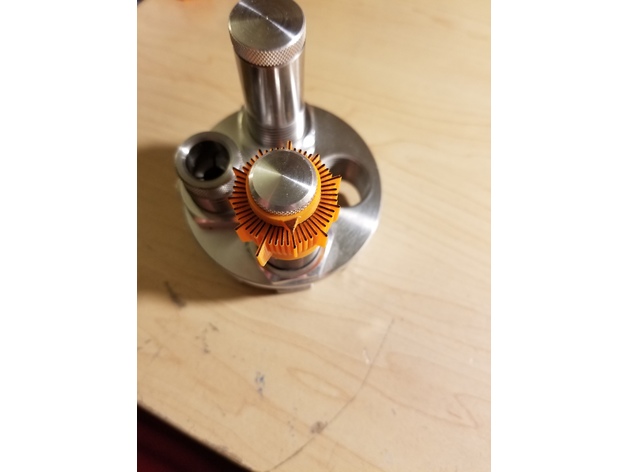
 www.thingiverse.com
www.thingiverse.com
CGTK - Divider Wheel Generator
I printed out something similar to what you want on a 3D printer, but it only works on Lee rifle dies, you possibly could find someone to modify it for a pistol die.

Seating Die Dial by Janius_Elgin
The seating die dial was designed to be a "poor-man's competition seating die". Each increment is equivalent to 0.001" based on a 18 pitch plunger. This was modeled around a Lee seating die, but i suspect that it will fit most dies. Also please note that gap between the large starting point and...
Thanks for posting this link!What about a degree wheel mounted to the press or lock ring (washer would help) then an indicator on your die.
There might be places to purchase one the size you need, here you can put any numbers in for your dial and print it out.CGTK - Divider Wheel Generator
www.cgtk.co.uk
I printed out something similar to what you want on a 3D printer, but it only works on Lee rifle dies, you possibly could find someone to modify it for a pistol die.

Seating Die Dial by Janius_Elgin
The seating die dial was designed to be a "poor-man's competition seating die". Each increment is equivalent to 0.001" based on a 18 pitch plunger. This was modeled around a Lee seating die, but i suspect that it will fit most dies. Also please note that gap between the large starting point and...www.thingiverse.com
Changing the "element;" for the thread pitch (threads per inch) of the expander will generate a dial that would be appropriate here.
If the OP has no thread pitch gage, just count the number of thread peaks in a 1/2 inch of length and X2 for the thread pitch.
""If you know the pitch of the thread, dividing 1 by the pitch will get you the amount the screw advances per revolution.
As an example: a 1/4x20 thread would be 1 divided by 20 (the pitch) equals 0.050" per revolution.""
In that example, the "element" in linked software would be 50:
CGTK - Divider Wheel Generator
During the printing-out of that dial, it can be shrunk to the proper size dial for this application.
Thanks again for the link...
jmo,
.
Otto
Member
- Joined
- May 14, 2007
- Messages
- 2,355
Mainly because there is practically no demand for them.Why No Micrometer Adjusting Expanders?
Another thing is cost. A Lyman M die is $30. But if they added a micrometer, you could expect the price to increase to a $100 or more.
CQB45ACP
Member
Youse guys are very innovative
Thanks
Thanks
CQB45ACP
Member
I know I know but it’d be awesome and you know it.Mainly because there is practically no demand for them.
Another thing is cost. A Lyman M die is $30. But if they added a micrometer, you could expect the price to increase to a $100 or more.
I paid more than that for Redding’s micrometer seaters and nearly that for micrometer taper crimp and half that for a micrometer insert for standard die.
I know it’s not even necessary (@jmorris even showed pictures proving it) and I figited around this AM with my paint dots but none of that makes a difference—I want a micrometer.
So, a micrometer has a thread pitch of 40 threads per inch, one turn is 0.025", and why the spindle has 25 graduations around it.I know I know but it’d be awesome and you know it.
I paid more than that for Redding’s micrometer seaters and nearly that for micrometer taper crimp and half that for a micrometer insert for standard die.
I know it’s not even necessary (@jmorris even showed pictures proving it) and I figited around this AM with my paint dots but none of that makes a difference—I want a micrometer.
Any screw with 40 threads per inch could be considered a "micrometer" in that respect.
I'm not sure why you are hung up on the word (micrometer) when any screw can be calibrated with an index wheel or measured with a caliper.
Granted it will not indicate any exact measurement but that's not needed for an expander plug, only the movement withing one revolution.
I'm guessing you already have a dial/digital caliper, here's another use of it, typical for seating dies.
I have even used a caliper to return a powder measure to a previous setting and the weight was exactly the same:
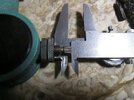
On a PM that has a micrometer spindle available from RCBS for $$$.
Good luck on your quest going forward.
jmo,
.
Last edited:
- Pistol reloading isn't nearly as exacting as rifle reloading, the distances, velocities and typical accuracy requirement doesn't warrant such fuss
- There is literally nothing exacting about expanding the case, does the bullet fit, good to go, anything more is seriously over thinking
- I set my 9mm and 45ACP expander once, many many years ago and haven't changed it since
ETA: All of my pistol reloads are made from scalped range brass of varying head stamps. If it were an issue, I'd have seen it.
- There is literally nothing exacting about expanding the case, does the bullet fit, good to go, anything more is seriously over thinking
- I set my 9mm and 45ACP expander once, many many years ago and haven't changed it since
ETA: All of my pistol reloads are made from scalped range brass of varying head stamps. If it were an issue, I'd have seen it.
Last edited:
Otto
Member
- Joined
- May 14, 2007
- Messages
- 2,355
I never said I wouldn’t buy one.I know I know but it’d be awesome and you know it.
I paid more than that for Redding’s micrometer seaters and nearly that for micrometer taper crimp and half that for a micrometer insert for standard die.
I know it’s not even necessary (@jmorris even showed pictures proving it) and I figited around this AM with my paint dots but none of that makes a difference—I want a micrometer.
In fact, my hobby is spending money on stuff I don’t need.
Similar threads
- Replies
- 2
- Views
- 257
- Replies
- 31
- Views
- 1K
- Replies
- 44
- Views
- 1K
- Replies
- 17
- Views
- 419

